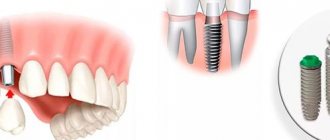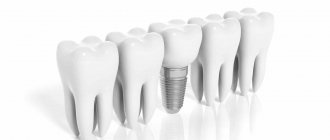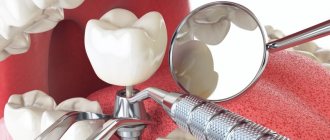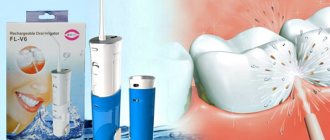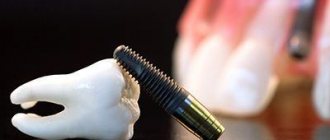Implantation without an incision is a marketing name that reflects the meaning of the procedure. This type of implant installation is also called transgingival, endoscopic, non-surgical or bloodless. This treatment has been known in Europe for 15 years , in Russia - relatively recently, but the popularity of the method is growing.
The process of installing an implant without an incision
What is implantation without a gum incision?
First, let's figure out what classical implantation is. This protocol involves the introduction of a titanium root (implant) into the bone tissue at the site of the missing tooth. The surgeon acts like this:
- Cuts the mucous membrane.
- Folds back the gingival flap.
- If necessary, it builds up bone tissue.
- Places an implant.
- Places stitches.
- After the implant has healed, a permanent crown is installed.
Tooth restoration takes 5-6 months , since it requires healing of the gums, fusion of the implant with the bone tissue, and installation of a crown after osseointegration.
Unlike the classical method, implantation without incisions allows you to skip several stages and avoid large incisions in the gums:
- To install the implant, one hole with a diameter of several millimeters is made.
- The implant is implanted.
- A gum former or temporary lightweight crown is immediately installed.
- After the implant has healed, a permanent crown is fixed in 2-3 months .
This treatment is recommended:
- people with diseases of the endocrine and cardiovascular systems;
- for those who are against surgery.
The bloodless method accelerates the restoration of the dentition.
Is it possible to get implants without surgery?
With the classic implantation protocol, the patient is given a local anesthesia to ensure that the procedure is completely painless. Next, the implantologist folds back a triangular flap of the mucosa, forms a special bed and inserts the implant. The mucous membrane is returned to its place, fixed with self-absorbing sutures. Those who are frightened by such a description of implantation are looking for options on how to do without incisions.
Among the available technologies, we can highlight the use of a special knife, which cuts out a cylindrical depression at the implant installation site. In this case, after implantation, sutures are not placed on the gums.
PROMOTION
Osstem dental implantation turnkey
18,000 rub.
Features of the method
The method is not suitable for patients with bone deficiency for reliable fixation of an artificial rod. It is impossible to increase bone mass without making an incision in the gums, so non-surgical treatment is available to only 5% of people.
The volume of the mucous membrane is also taken into account. If the gum thickness is less than 2 mm, an implant cannot be installed using a non-surgical method. Under the influence of the titanium root, the mucous membrane will stretch and become even thinner. The thinner the gums, the greater the risk of inflammatory processes and implant rejection. The fact is that opportunistic bacteria, which are normally found in the oral cavity, can seep through the thin soft tissue and destroy the bone underneath. For thinned gums, we recommend enlarging the incision and performing implantation using a patchwork method.
In our Center, implantation without incisions is not covered by a lifetime guarantee.
Related articles:
- Other implantation methods
- Our guarantees
- Implant lifespan
Compliance with conditions
Dental implantation
non-surgical method, or as it is also called, transgingival, has contraindications:
- Inflammatory process in the periodontal area (exacerbation);
- Insufficient tissue volume - bone and soft;
- Poor bone quality in the area where the tooth is missing;
- Poor performance of primary implant stabilization.
Contraindications can be relative and absolute, general and local, and are temporary. For more details, it is better to consult your doctor!
We must not forget that despite the huge number of advantages, this is still an operation. This means that you need to take a responsible approach to choosing a dentist. A competent implantologist will assess all possible risks.
Implantation using the incisionless technique: absolute contraindications:
- Diseases of the blood and hematopoietic organs;
- Mental problems;
- Connective tissue diseases;
- Malignant tumors;
- Tuberculosis, including complicated;
- Poor immunity;
- Diabetes;
- Bruxism;
- Allergy to drugs used;
- Endocrine disorders;
- Osteoporosis.
Relative contraindications:
- Caries;
- Poor oral hygiene;
- Pathological bite;
- Inflammation of the gums;
- Arthrosis of the jaw joints;
- Periodontitis;
- Pregnancy;
- Smoking, alcoholism, drug addiction;
- Atrophied alveolar processes of teeth.
Relative means contraindications that can be overcome.
What does smoking have to do with it? A smoker is more likely to experience implant failure than the average person. This is why it is recommended to give up cigarettes two weeks before the procedure.
General contraindications:
- Allergy to anesthetics;
- General somatic diseases;
- Taking medications prescribed by other doctors;
- Unstable psychological state due to stress;
- Exhaustion.
Local contraindications:
- Bone atrophy in the area where the implant is planned to be placed;
- The gap between the working area and the maxillary and nasal sinuses is too small.
- Temporary contraindications:
- Diseases in the acute stage;
- Rehabilitation period;
- Recent radiation therapy;
- Alcoholism.
Stages of bloodless implantation
With the seamless method, the implant is inserted through a puncture of the gum. Before the puncture, local anesthesia is given or the patient is put into medicated sleep.
- Using a circular mucotome, a circular incision is made for the titanium root. Preparing the hole begins by marking it with a ball bur. Sequential expansion is carried out using cutters of different diameters - from smaller to larger.
- Installation of an artificial root into the bone mass by screwing.
- Fixation of the healing abutment or abutment.
- It is possible to install a temporary lightweight crown immediately. After osseointegration, it is replaced with a permanent one.
Honestly about the disadvantages of implantation
Despite the significant advantages - restoration of the chewing load on the bone and stopping the atrophy of bone tissue, the feeling of the implant as if it were your own teeth, excellent appearance, durability and reliability, no need to grind down adjacent teeth - implantation also has its own disadvantages, which we will consider in detail.
1. Pain after implantation. Installation of an implant (or implant - everyone pronounces a foreign word differently) is a surgical operation with all the ensuing consequences - including pain for some time after the operation. During the normal course of the process, the pain goes away within a few (3-5) days.
2. Possible complications. One of the most serious complications is material rejection - the body does not perceive a foreign object and tries to get rid of it. Inflammation, pain, swelling, implant mobility, fluid secretion and even increased body temperature. To be fair, let’s say that the probability of such an outcome is very low - it is only 2-3% of the total number of people who have implants installed.
3. Presence of contraindications. Implantation, like most all medical procedures, has contraindications – situations in which it is impossible to install implants. These include: age under 20 years, diabetes mellitus (type 2), hepatitis, AIDS, other immune and cardiovascular diseases, bleeding disorders, bruxism and some others. Some of the contraindications can be circumvented, others cannot.
4. Long installation process. The installation itself can be carried out in literally 1-2 visits to the dentist, but the total period of engraftment of the artificial root can take from 6 months to 1-2 years. But in case of a favorable outcome (and this, we remind you, is 97-98% of all cases), you will have the same tooth as before, which will serve you without any problems for 10-20 years, or even more.
5. Caring for implants is more complicated than regular teeth, although not by much. They need to be cleaned more thoroughly, and you also need to regularly visit a dentist, who should monitor the condition of the implant and take timely measures if any problems suddenly arise.
6. The cost of implantation is very high. Prices for installing one implant start from 18,000 rubles - and this does not include the cost of the crown. In other clinics (especially in the capital), the total cost of a new tooth can exceed 100,000 rubles or more.
Still, the pros outweigh the cons in most cases. Otherwise, implantation would not be used so widely, and this technology, for a moment, is already more than 55 years old. The first operation was successfully performed by the developer of this technology and the founder of Nobel Biocare (which is still a leader in the scientific development and production of implants) Per-Ingvar Brånemark back in 1965.
Since then, millions of operations have been performed all over the world, several more large companies have appeared producing implants, instruments and components, implants of a more advanced form and from the latest, biocompatible materials have been proposed, the technology has been developed to perfection, and research into the consequences of implantation has become the most extensive nature, including many thousands of patients observed over decades. But still, let’s return to the disadvantages of implantation and analyze them more carefully.
Features of the operation in our Center
- We begin transgingival implantation by creating a 3D model of the jaw. Our Center uses the “Nobel Guide” system. She creates an accurate virtual model based on mathematical calculations and produces a surgical template. With it, the doctor will determine where and at what distance to place the implants without cutting the gums. A tomograph and an X-ray machine do not provide such accuracy. The very name “implantation without incision” was invented by marketers to promote the “Nobel Guide” protocol.
- When the surgical template is ready, the doctor places it firmly against the gum and makes one or more holes for the implants. The procedure is performed under local anesthesia or sedation and is painless for the patient.
- After inserting the rod, the doctor places a temporary crown if the tooth is in the smile zone.
- After 2-3 months, the patient comes to the clinic for the second time and leaves with a permanent crown, indistinguishable from a natural tooth. In classical technology, the last visit takes place six months after the start of treatment.
What is the cost of dental implants without surgery?
The average price of dental implantation without surgery is initially slightly higher than the classic one. However, the final cost of treatment using the transgingival method is several times cheaper, since its use does not require such additional and rather expensive manipulations as, for example, patch surgeries.
There is a stereotype among patients and some doctors that a good implant must be expensive. However, this statement is not always true. The implant is selected based on the individual characteristics of the body - in particular, depending on the density and volume of the jaw bone. The designs of different implant systems differ from each other, and sometimes a budget implant is more suitable for a patient than a premium product. In addition, thanks to diagnostics, the clinic can tell the patient the final cost of treatment in advance, which is undoubtedly a big advantage.
Rehabilitation period
Rehabilitation with the sutureless method takes less time compared to classical implantation. The operation is minimally invasive, without stitches, and therefore the implants take root quickly.
The risk of complications is minimal, since surgical manipulations practically do not injure fibrous tissue. But this does not mean that in the postoperative period the patient should not follow a certain regimen:
- On the recommendation of a doctor, antibacterial therapy, anti-inflammatory and painkillers are prescribed.
- On the first day you should not eat solid food.
- On the second day, if there is no pain, swelling and temperature, the gentle regime and anti-inflammatory drugs are canceled.
In what cases is bone grafting required?
It is impossible to successfully install dental implants without bone augmentation in the following situations:
- The patient is missing several teeth in a row and there is severe atrophy of the jaw bone in height, width, or width and height at the same time.
- For severe forms of periodontitis.
Important!
If bone atrophy is so great that there is a high probability of damage to the maxillary sinus and mandibular nerve, and the use of short and narrow implants increases the risk of rejection of the structure, not a single doctor will install implants without first building up the bone.
To find out whether bone grafting is required in your case, sign up for a free consultation at any of the NovaDent clinics in Moscow and the Moscow region.
Expert of the article you are reading: Griboyedov Pavel Olegovich Implantologist, Orthopedic Dentist, leading specialist of the NovaDent network
14 years
Clinical experience
Skhodnenskaya
Khimki Boulevard, 14, bldg. 2
+7
Free consultation with this specialist
Benefits of non-surgical implant installation
- The time to restore the dentition is reduced: after a maximum of 3 months, the patient is fitted with a permanent crown.
- The operation is faster: installing the rod using the classical method takes up to 8 minutes, and using the bloodless method – up to 2 .
- Rehabilitation is made easier: patients do not experience bruises, swelling, pain, or fever, and can work the next day after the implants are installed. It is especially important when restoring several teeth.
- The risk of implant rejection and infection is reduced since it does not require separation of the gum from the bone.
- Takes 10-15 minutes . Unlike the classic 3-stage method, with a non-surgical method the doctor installs a gum former or temporary crown immediately, without waiting for healing. The rehabilitation period is reduced by 2-2.5 times .
Traditional and transgingival implantation
Traditional implant placement is very traumatic. Installation of the product and the adaptation period require a lot of time, so experts prefer the non-surgical method of implanting dental structures. Traditional pin installation consists of the following steps:
- The specialist eliminates existing dental problems (tartar, caries, periodontal disease). After this, an implant is selected and an impression of the jaw is made. An incision is made on the periosteum and mucous membrane to introduce a bed under the product.
- After the operation, you must adhere to all the specialist’s instructions. As a rule, the patient is prescribed antibacterial and anti-inflammatory drugs and rinsing the mouth with antiseptic drugs.
- Osseointegration of the product lasts six months, then the specialist installs the abutment and temporary crown. After this, the doctor recommends coming back in two weeks. If during this period the healing process is successful, then a permanent crown or prosthesis is placed.
When dental implants are installed without a gum incision, this significantly reduces the healing time - the product takes from one to two months. In addition, there is no trauma or damage to the jaw nerve.
Price
Speed of the procedure does not mean cheaper. The amount of consumables and the cost of doctors’ work does not decrease. On the contrary, the price of implantation without an incision is higher due to:
- manufacturing a surgical template;
- mandatory three-time computed tomography.
The cost of a case for treatment is from 60,000 rubles . The amount includes the necessary procedures, the patient will not have to pay extra. For comparison, in Moscow clinics the price of the procedure starts at 45,000 rubles, but usually this amount is not final.
Where is non-surgical implantation performed?
Dental implantation without incision in Moscow
allows you to restore the functions of lost teeth. This is a long-term prosthetic technique. Implantologists from the Leaderstom clinic network are among the top best specialists.
Moscow offers a large number of dental clinics. But if quality is important to you, then contact Leaderstom, because here:
- Much attention is paid to preparation for the procedure. The clinic’s specialists carefully approach each patient, take into account all possible risks, and dental implantation
is carried out safely and efficiently. - Implantologists have completed over 1,000 successfully performed implant installation operations. about how successful dental implantation
. - Another important feature is communication. You can freely ask the clinic specialists any questions, including non-standard ones. The doctors are polite, non-irritable and friendly. Do you want to undergo treatment in comfort? Then don't miss your chance!
- If there are contraindications to dental implantation without surgery in Moscow,
you will be the first to know about it. The implantologist at the Leaderstom clinic will tell you whether this problem can be solved and how to do it. If there are temporary contraindications, they are easily overcome. - The dental network uses implants of the highest quality processing and manufacturing.
- An important advantage of the clinic network is its maximum availability of modern equipment.
- Implantologists at a network of clinics in Moscow constantly monitor new technologies and take advanced training courses, so they have the latest information regarding available treatment methods.
As a result, what advantages do you get when contacting the Leaderstom clinic network:
- One hundred percent absence of pain;
- An integrated approach to solving dental problems;
- Information transparency: familiarizing patients with treatment options and the cost of services at each stage;
- Carrying out any work by the hands of highly qualified professionals;
- High quality of non-surgical dental implantation in Moscow;
- Work aimed at the convenience of the client.
Options for implantation without incision
Implantation without surgery can be conditionally called 2 more types:
- Laser - a laser beam is used instead of a scalpel. The bloodless incision of the gum is accurate, while at the same time disinfecting the area and minimizing the wound healing time is ensured.
- Instantaneous immediately after tooth extraction - there is no need to make incisions in the gums, since the implant is implanted into a fresh socket. But it is not always possible to carry out the extraction carefully, and the disfigured socket is not suitable for installing an implant.
Features of dental implants - important facts
The most popular implants used for dental implantation are cylindrical or screw. According to their parameters, they imitate the natural tooth root.
Technology manufacturers do not stand still and offer various solutions for implantation: with specific thread geometry, spraying a thin layer of bone-active compounds. The surface also has a porous texture that absorbs interstitial bone fluid.
Separately, it is worth highlighting prosthetic technologies based on titanium implants. Screw systems serve as a connecting link between the prosthesis and the dental implant - they are screwed into the thread of the intraosseous part of the dental implant.
Thus, as a result of implantation and prosthetics, a stable position of the crown is guaranteed, which will not break off under chewing load.
Types of one-stage implantation
- the organ is removed
and a rod with a temporary structure is immediately screwed into the socket of the extracted tooth, which is replaced with zirconium or ceramic after 2-4 months; - the dental unit is removed
, an operation is performed and a former is mounted - this makes it possible to obtain the desired gum design for the future neck of the crown, which is mounted after osseointegration, and a temporary removable prosthesis is made; - if the bone condition is unsatisfactory
, the implant is implanted immediately after extraction, but the crowns are installed only after complete osseointegration - anatomical and functional joining between the bone being changed and the surface of the rod, in order to eliminate the risk of its rejection.
Single-stage implantation is an effective technology that can improve aesthetic/functional results, reduce treatment time, prevent atrophy, and reduce the amount of orthopedic/radical interventions.
For a successful operation, it is necessary to carry out atraumatic extraction, the presence of an adequately configured titanium root as the basis, correct formation of the bed, and filling of the free space with osteoplastic material.
Contraindications to implantation, which may cause pain
Contraindications to implant installation include:
- diabetes mellitus in the stage of decompensation;
- oncological diseases treated using chemotherapy and radiation therapy;
- thyroid diseases;
- smoking;
- diseases of the oral cavity.
In the presence of these pathologies, not only the process of installing artificial structures, but also their engraftment may become problematic and can lead to painful complications.
In all of the above situations, you must definitely consult with your dentist and do all the necessary diagnostic tests to make sure there are no obstacles to implantation. However, if you have no contraindications, you should not be afraid of the painfulness of the procedure, because modern implantation is an effective, time-tested and safe method of prosthetics!
An implant installed by an experienced specialist will last quite a long time – about 20 years. It is quite possible to carry out the procedure in one visit to the dental clinic. Provided that the patient’s oral cavity does not require sanitation and he is absolutely healthy.
How much does it cost to place a dental implant in Moscow?
The price of the service for installing implants of front and back teeth depends on the amount of work performed. The price includes: tooth extraction, implantation of a titanium root, installation of a temporary crown or former. The choice of professional technique depends on the current situation in the oral cavity, individual characteristics and health status of the patient.
You can find out how much it costs to install a dental implant and make an appointment for a consultation at our dental clinic in Moscow by calling 8.
| Code no. | NAME OF PROCEDURES | Unit of measurement | Cost, rub. |
| 649 | Installation of the Nobel system implant (USA) | 1 PC. | 60 000,00 |
| 652 | Installation of the Inno/Alhpa-bio system implant | 1 PC. | 35 000,00 |
| 654 | Placement of the gum former with gingival contour plastic surgery | 7 000,00 |
* The prices indicated on the website are not a public offer. The exact cost of treatment can only be determined at an appointment with a doctor.
Prices for treatment in Moscow full price list
Share on social media networks:
Article Expert:
Lavrentyev Sergey Sergeevich
Doctor - dentist, surgeon, implantologist. He regularly improves his professional level and studies modern methods of dental implantation and surgical dentistry at international seminars and conferences of outstanding implant surgeons in the world.
Work experience 25 years
Comparison with other implants
You can compare compression implants with the main types of implants:
- basal artificial roots for basal implantation. They are longer because... installation takes place in the distant dense membranes (bypassing the cancellous) bone. When using them, the volume of tissue is not important; the pin reaches the cortical layer. Allows you to avoid osteoplasty surgery.
- classic implants. They are universal, but the quality of the fabric is important, and compression ones are already used with an average degree of loss. A traditional root implant is used in single restorations.
- Dentists consider multi-unit implants with screw fastening to the prosthesis in cases of completely edentulous jaws. This system is more expensive, but allows you to remove/put on the structure to replace a part or service.
